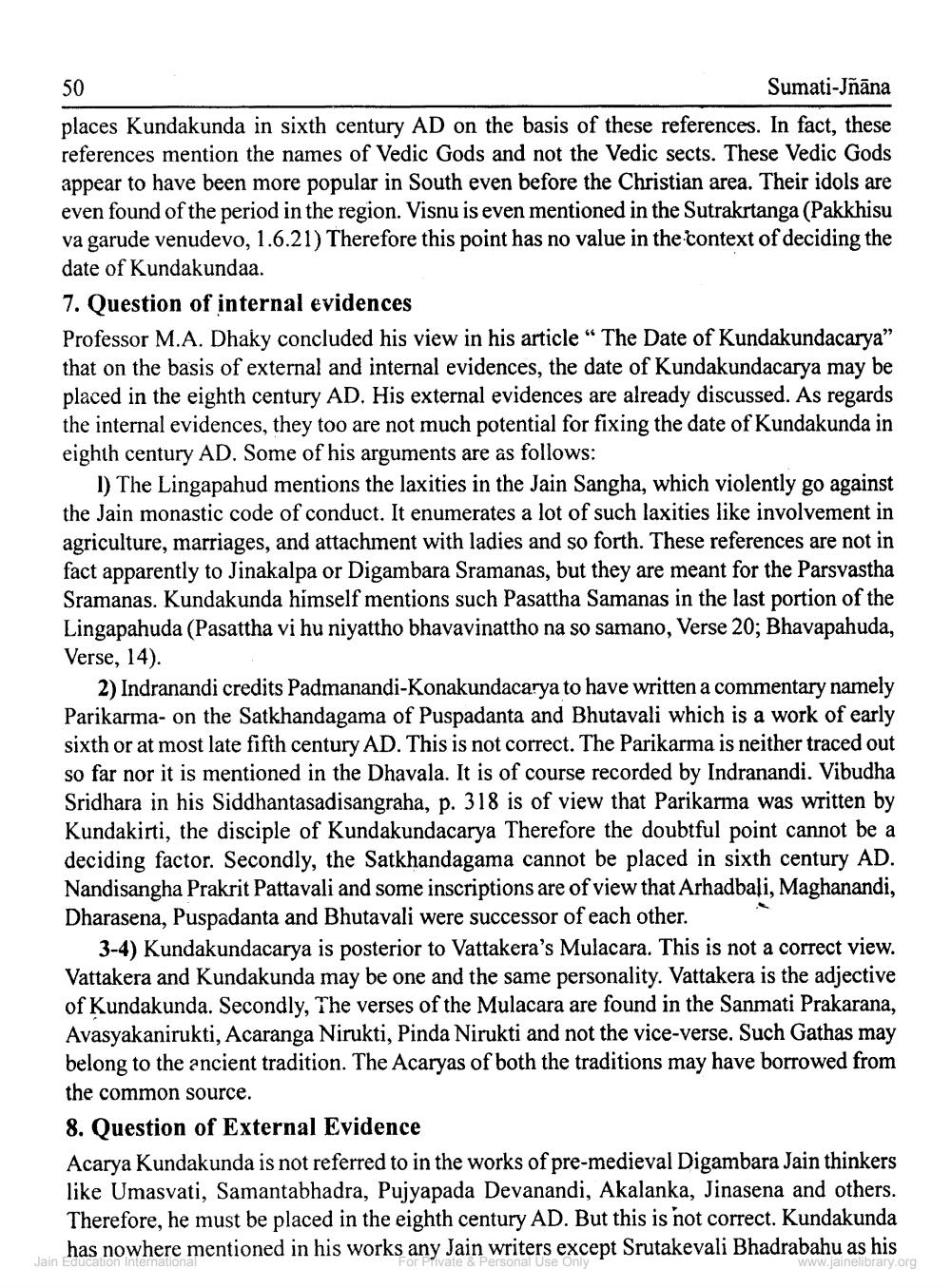________________
50
Sumati-Jñāna places Kundakunda in sixth century AD on the basis of these references. In fact, these references mention the names of Vedic Gods and not the Vedic sects. These Vedic Gods appear to have been more popular in South even before the Christian area. Their idols are even found of the period in the region. Visnu is even mentioned in the Sutrakrtanga (Pakkhisu va garude venudevo, 1.6.21) Therefore this point has no value in the context of deciding the date of Kundakundaa. 7. Question of internal evidences Professor M.A. Dhaky concluded his view in his article " The Date of Kundakundacarya" that on the basis of external and internal evidences, the date of Kundakundacarya may be placed in the eighth century AD. His external evidences are already discussed. As regards the internal evidences, they too are not much potential for fixing the date of Kundakunda in eighth century AD. Some of his arguments are as follows:
1) The Lingapahud mentions the laxities in the Jain Sangha, which violently go against the Jain monastic code of conduct. It enumerates a lot of such laxities like involvement in agriculture, marriages, and attachment with ladies and so forth. These references are not in fact apparently to Jinakalpa or Digambara Sramanas, but they are meant for the Parsvastha Sramanas. Kundakunda himself mentions such Pasattha Samanas in the last portion of the Lingapahuda (Pasattha vi hu niyattho bhavavinattho na so samano, Verse 20; Bhavapahuda, Verse, 14).
2) Indranandi credits Padmanandi-Konakundacarya to have written a commentary namely Parikarma- on the Satkhandagama of Puspadanta and Bhutavali which is a work of early sixth or at most late fifth century AD. This is not correct. The Parikarma is neither traced out so far nor it is mentioned in the Dhavala. It is of course recorded by Indranandi. Vibudha Sridhara in his Siddhantasadisangraha, p. 318 is of view that Parikarma was written by Kundakirti, the disciple of Kundakundacarya Therefore the doubtful point cannot be a deciding factor. Secondly, the Satkhandagama cannot be placed in sixth Nandisangha Prakrit Pattavali and some inscriptions are of view that Arhadbali, Maghanandi, Dharasena, Puspadanta and Bhutavali were successor of each other. .
3-4) Kundakundacarya is posterior to Vattakera's Mulacara. This is not a correct view. Vattakera and Kundakunda may be one and the same personality. Vattakera is the adjective of Kundakunda. Secondly, The verses of the Mulacara are found in the Sanmati Prakarana, Avasyakanirukti, Acaranga Nirukti, Pinda Nirukti and not the vice-verse. Such Gathas may belong to the ancient tradition. The Acaryas of both the traditions may have borrowed from the common source. 8. Ouestion of External Evidence Acarya Kundakunda is not referred to in the works of pre-medieval Digambara Jain thinkers like Umasvati, Samantabhadra, Pujyapada Devanandi, Akalanka, Jinasena and others. Therefore, he must be placed in the eighth century AD. But this is not correct. Kundakunda has nowhere mentioned in his works any Jain writers except Srutakevali Bhadrabahu as his For Private & Personal Use Only
ww.jainelibrary.org
Jain Education intem




